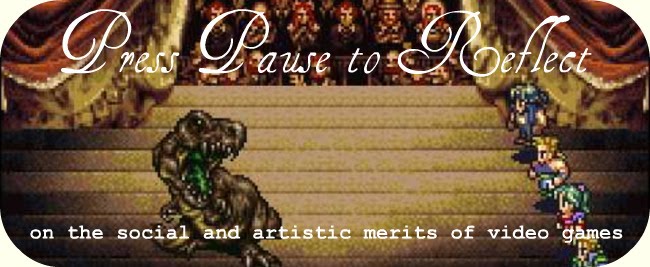by C.T. Hutt
There can be little questioning that the artistic medium of video gaming is still in its infancy. Despite this, there is no denying the existence of established genres. We have the first person shooter, the side-scrolling platformer, the fighting game, the RPG, and so on. Even games which push the boundaries of these classifications such as Mass Effect or Portal often end up awkwardly piled in with others. I feel it is one of the great failings in human thinking that we are given a sense of comfort when we attempt to dissect creative work and file it neatly away. I understand why it’s done of course; it makes the sublime more accessible, the infinite and indefinable more commonplace, and it cools the blazing power of imagination down to the lukewarm temperature of logic. Just occasionally, however, something in the art world comes along that refuses to be classified or contained in the established ways. It is these bold endeavors that truly lead us to new and wonderful frontiers in the arts. I have seen the beginnings of such genius reflected in The Path by Tale of Tales.
If Edgar Allen Poe had programed a video game for his estranged daughter it would probably look a good deal like this. The Path is a dark, confusing, and truly absorbing adaptation of the classic children’s story Little Red Riding Hood. Players take control of one of six sisters who are charged with the simple task of delivering a basket of goodies to grandmother’s house and are warned not to stray from the path that leads there. Any diversion from this task leads your character into a dark forest filled with all manner of strange and interesting sights, sounds, and feelings. Exploring this enchanting place is not all light and games. The more one plays, the more they get the feeling that there is something sinister in the forest, always just out of sight.
Things only get stranger when a player makes it to Grandmother’s house. No tea and cookies await your arrival; instead the player is treated to a surreal digital funhouse, made more extensive and interesting by the amount of exploring accomplished before arriving there. Rules of physics and time twist into a fantastic display of just how far the gaming medium can challenge our perceptions. All through the experience is the chilling suspicion that there is something right behind you.
Perhaps the most unique effect of The Path is the emotional cord it pulls in the gamer. It is not the visual effects of the game itself so much as our own imaginations which provide the real thrills. There are very few actual boogiemen in The Path; whatever monsters may lurk in the shadowy forest never truly unmask themselves to us. Instead of showing us the face of fear, this game evokes a long-buried ability in all of us to make every shadow into a ghost and every gust of wind into a monster’s wail. No matter how many times I checked, I was quite certain that there was a wolf hiding somewhere in my apartment Wednesday night just waiting for me to nod off.
I have been, and probably always will be, a meat-and-potatoes narrative man. I know it is a weakness to have such a limited palate, but frankly, I like my story arcs to look like mathematically perfect parabola. The Path is much more like guiding an avatar through an abstract poem than a traditional story, as such it doesn’t quite satisfy my finicky appetite for a clear beginning, middle and end. Nevertheless, there is no doubt that Tale of Tales is showing the gaming world exactly what it needs to see: that there is more to this new medium then what we are familiar with, that video games can be emotionally evocative in their own right, and most importantly that we, as gamers, should expect more from developers then overused conventions.
I heartily encourage all gamers to turn out the lights and give this one a try. It can be downloaded through Steam and The Path website.
One of my favorite things about the indie gaming scene is that developers are more accessible and receptive to inquiry then their larger counterparts. Rather than post on some oft-ignored forum and wait four months for a one-line reply, I’ve had the pleasure of sharing some correspondence with Michael Samyn and Auriea Harvey, the directors and founders of Tale of Tales. They shared with me some reflections on gaming and the arts which I will post next week.
Friday, June 5, 2009
The Path Less Traveled
Tags:
Art,
Horror,
Little Red Riding Hood,
Poetry,
Tale of Tales,
The Path
Subscribe to:
Post Comments (Atom)

No comments:
Post a Comment
Note: Only a member of this blog may post a comment.